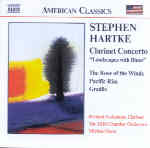Hearing this disc got me to thinking, which I know is probably a mistake but please bear with me. If you studied music over the past couple of decades, you would have learned that after Mahler, tonality ended. Then atonal and serial music ruled the musical roost until the minimalists arrived on the scene in the 1960s, followed by the neo-Romantics in the ’70s and ’80s. The huge number of composers, especially in America, Russia, and England (not to mention lots of other countries that never seemed to figure in music history books) who remained faithful to tonality belonged to a school of stubbornly regressive, anachronistic has-beens, however much craft and talent went into their music. The ultimate turn to 12-note composition of such neo-classicists as Stravinsky and Copland only confirmed the orthodox line. It was (and still is) a story curiously at odds with musical reality, as any avid concertgoer or record collector can attest.
But something else was also going on. Way back in 1888, the Paris Exposition confronted many Western composers with true Balinese music for the first time. The influence of Asian musical modes and the rage for all things Eastern had an enormous impact on Debussy and Ravel (and the entire French school). It already had been a colorful mainstay of the Russian nationalists and had found a fruitful advocate in Mahler’s Das Lied von der Erde–and even in Sir Arthur Sullivan’s Mikado. After the First World War, composers as diverse as Hovhaness, Harrison, Cage, Cowell, Britten, McPhee, Holst, and Messiaen (to name only a few) continued this fruitful line of development. Combine this with the Mahler boom of the 1960s, which was incredibly important because it legitimized musical eclecticism and demonstrated that a mélange of musical styles and influences could be successfully combined in a single unified composition, and it seems increasingly evident that this is by far the more important (and continuous) historical line of 20th century musical evolution, and it is the academic serial composers who should be regarded as the real “outsiders”.
I say this because Stephen Hartke’s music shows all the advantages of a composer who feels free to range far and wide for sources of musical inspiration, and who understands that a priori theorizing about what constitutes a valid style is less important than the creativity and imagination brought to bear on the material at hand. His Clarinet Concerto reveals this very clearly, and surely constitutes one of the major contributions to a little-explored genre. If you enjoy Gershwin’s Piano Concerto you will find many formal similarities here: the jazzy opening movement followed by a bluesy nocturne with a quick contrasting middle section, and of course a dazzling finale. But while Gershwin’s style consisted of a mixture of jazzy popular song and classical form, Hartke roams farther afield, starting in Africa with the solo clarinet as main story teller and the orchestra as chorus, the whole over a basso ostinato running through the entire movement.
The long central nocturne displays a very impressive command of musical timing. After its opening meditation some wild party music brings Messiaen to mind (listen to the recurring percussion rhythms), leading in turn to some exquisitely beautiful melodic writing for the soloist, a brief return to the mood of the opening, and a lovely coda that closes the movement in a mood of quiet poetry. The contrasts of tempo, texture, and tone are so well planned that the music’s 15 minutes pass by in a flash. To start the finale, orchestra and soloist argue for a bit in the opening measures, and then a more fluent quick section yields to yet another island of lyricism before everything comes together for the abruptly brilliant ending. As might be expected, Richard Stoltzman plays excellently, and Michael Stern leads a vivacious performance of music at once colorful, witty, and soulful–a classic example of what can be achieved when formal discipline meets an unfettered imagination.
The Rose of the Winds for string octet–a sort of Vaughan Williams Tallis Fantasia for the new millennium–opens with a clear reference to medieval music, the players imitating a consort of viols. Once the quick section gets going we recognize one of Hartke’s stylistic fingerprints: a swift lyrical melody punctuated by staccato jabs that energize the rhythm and enrich the music’s texture. It’s a lovely work. Gradus, scored for the unlikely combination of bass clarinet, vibraphone, piano, violin, cello, and double bass revels in unusual color combinations and fills its seven minutes with abundant energy and character. Finally, in Pacific Rim, the composer’s vibrant tribute to his Los Angeles home, we hear perhaps most vividly that Eastern (and Latin)-tinged, Mahlerian melting pot of influences that are revitalizing our musical culture for the next hundred years even as they stretch their roots back over the previous hundred.
It doesn’t diminish at all the value of Hartke’s work to attempt to situate him within this musical mainstream (at least as I define it); his talent and skill are self-evident. But pointing out these references might, if you are a listener coming new to his output, give some assurance that as with all of the best contemporary “classical” music, you will find plenty of traditional “anchors” that allow you to get your musical bearings, even as Hartke boldly goes where no composer has gone before. Knowing that Hartke was co-producer of this disc, we can take for granted the fact that the performances represent his intentions, and they all sound really splendid–technically polished and emotionally committed. Naxos captures the proceedings with engineering of uncommon clarity, immediacy, and warmth, making this an exceptionally rewarding entry in the label’s American music series. Hartke’s is a major voice in music today. Do get to know him.
































